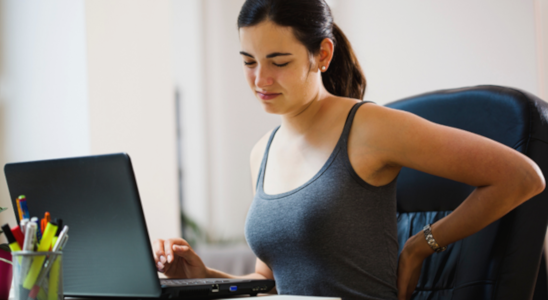Working from Home and Its Impact on the Body
Tuesday, August 03, 2021, 09:45 AM
As provinces continue with their reopening plans across Canada, many are navigating new working environments. While some people may return to the office, others are facing full-time remote work or a combination of the two.
Whether you are working from home or heading back into the office, your ergonomic environment can wreak havoc on your postural muscles.

Let's explore what you can do as a client to improve postural strength and how massage therapists can help you find long-lasting relief. We'll also look at other treatments that may complement massage therapy.
The Client: How Your Working Environment Impacts Your Body
Remaining in the same position for long periods of time can cause muscles to stiffen. When holding a certain posture, such as sitting at your desk, some muscles work overtime to hold you in place, while other muscles do not work at all.
Our bodies are made to move, not to stay sitting all day, so movement is important to keep body systems functioning.
The lymphatic system, an important part of our immune and circulatory systems, relies on muscle movement to keep fluids moving throughout the body. The lymphatic system does not have a pump like the heart, but instead relies on movement to function properly.
Common effects of repetitive postures and limited movement include an increased risk of muscle contracture (shortening and hardening of the muscle tissue) or inflammation. This can cause lasting damage such as limiting your range of motion in the affected area.
Being sedentary can also lead to many health conditions like stroke, heart disease, and obesity.
Massage can help address postural issues by lengthening muscles and keeping them limber. Your massage therapist can help correct postural imbalances and suggest purposeful stretches that can be done at home to complement your treatment and keep you active.
In addition, consider how you can make your workspace more ergonomic, and set reminders to move and stretch your body every hour. Try using an ergonomic chair to help posture, a keyboard wrist rest to support your wrists, or a laptop stand to bring your screen to eye level.
For stretches, try shoulder shrugs, neck rolls, chin-to-chest, or other stretches to relieve neck tension at home!
The Practitioner: Improving the Negative Effects of Poor Ergonomics
If you are a massage therapist, you will likely encounter a client with postural issues, especially with the influx of individuals working from home. We asked Candace Pichonsky, our Practice Competency Manager, for some related practice management advice for therapists.
How can you guide clients to be more mindful of their posture?
Ask questions! Bringing clients "back into their body," or simply educating them about what their body is telling you, is important. Asking questions empowers the client to be more in tune with the treatment you give and encourages them to pay attention to their body's signals.
There is often something in the client's environment that is causing an issue. One very important question to ask is "what do you for most of your day?".
Is the client sitting at a desk, standing at a kiosk, or driving for eight hours? This determines what their main posture will be and what they should be doing to compensate for being in the same posture for extended periods.
How do you get a client to be receptive to a discussion about their posture?
Sometimes telling a client that their wellness is a two-way street can help. Massage will not "fix" improper posture or overworked muscles. They must adjust their behaviour in some way. Challenge them to do what you suggest for one week and get feedback next time they are in.
If a client has no interest in doing things to help their pain and continually comes in with the same issue for you "fix," you may not be the right fit for them. In this case, you can refer the client to another therapist or seek advice from our Practice Management Team.
Other Holistic Health Practices
In addition to massage therapy, other holistic health care options that may help posture-related issues include:
- Acupressure: this treatment stimulates energy flow throughout the entire body through the manipulation of trigger points.
- Hot Stone Therapy: this is a type of massage that uses heated stones on the body to promote deep muscle and tissue relaxation and improve circulation.
- Aromatherapy: Japanese mint oil is a soothing option after a massage therapy treatment, as it helps cool sore muscles.
It is important to understand that there is no magic solution for posture-related pain. Listen to your body and consult with your practitioner to create an effective treatment plan.

